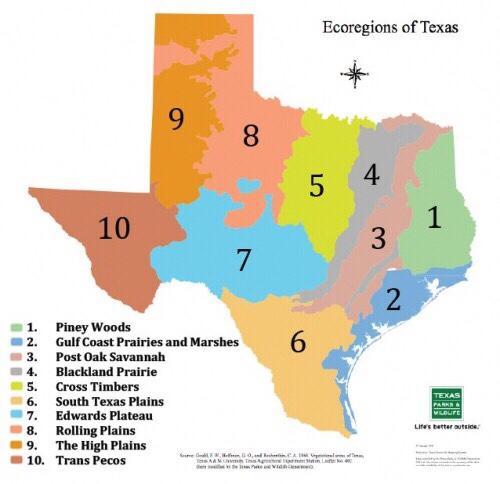#texas ecoregions
Text
'Tism won again! 🎉
Re:that post about invasive mints and the addition about outcompeting them with related plants, you can look up native lamiaceae species if you're still worried about replacing one invasive species with another! If you live in the USA, uswildflowers.com lets you search by state, and if you wanna narrow your search results even more, look up [plant family] native to your ecoregion!

There are different-level ecoregional maps for each state too--

--and some species only occur in the wild within unique subregions. For example, there's a Brazos mint, or rattlesnake flower, that only grows in sandy soil within the post oak belt in Texas, and the post oak savannahs only show up within the east central Texas plains on a level IV-inclusive map.
And I dunno about anyone else, but there's something special about meeting some of your more exclusive neighbors.
#mint#lamiaceae#invasive species#native plants#ecoregion#environmentalism#gardening#media#website#tldr#etc
358 notes
·
View notes
Text
I had no idea what is the "high plains" ecoregion of Texas. Well, now I know.

i see new images of plamnet earht every day.
15 notes
·
View notes
Text
Excerpt from this press release from the Department of the Interior:
The Department of the Interior today announced the expansion of four existing national wildlife refuges, which will allow for the voluntary conservation of up to 1.13 million acres of wildlife habitat in New Mexico, North Carolina and Texas.
Investing in and expanding the National Wildlife Refuge System, managed by the U.S. Fish and Wildlife Service, furthers the Biden-Harris administration’s work to support community-driven efforts to conserve and restore the nation’s lands and waters through the America the Beautiful initiative. Under Secretary Haaland’s leadership, the Department has also established four new Refuges that will help conserve important fish and wildlife habitat, support working lands, and expand opportunities for outdoor recreation.
The new expansion areas include:
Roanoke River National Wildlife Refuge (NC) may now conserve up to 287,000 acres of floodplain habitat along a 137-mile stretch of the Roanoke River from Weldon to the Albemarle Sound, to support rare and at-risk species like the Atlantic sturgeon, cerulean and Swainson's warbers, bald eagles and migratory waterfowl. The refuge was established in 1991 to protect the forests in the Roanoke River floodplain, considered to be the largest intact, and least disturbed, bottomland forest ecosystem remaining in the mid-Atlantic region.
Aransas and Big Boggy National Wildlife Refuges (TX) may now conserve up to 150,000 additional acres of habitat in the Gulf Coast Prairies and Marshes ecoregion of Texas to support whooping crane, Eastern black rail, Attwater's prairie chicken, mottled duck and other wintering waterfowl. Established in 1937, Aransas NWR serves as a refuge and breeding ground and for migratory birds and other wildlife and is best known as the wintering home of the last wild flock of endangered whooping cranes. Establishing in 1983 and designated an Internationally Significant Shorebird Site by the Western Hemisphere Shorebird Reserve Network, Big Boggy NWR is a stronghold for the threatened eastern black rail and provides seasonal and year-round habitat for large populations of waterfowl, wading birds, waterbirds, and shorebirds.
Muleshoe National Wildlife Refuge (NM and TX) may now conserve up to 700,000 acres of habitat in the Southern High Plains along the Texas-New Mexico border to support sandhill crane, pronghorn and lesser prairie chicken, as well as a full suite of other wildlife that rely on the grasslands, playa wetlands and saline lake habitats of the Central Grasslands. Established in 1935, the refuge is the oldest national wildlife refuge in Texas and is best known for hosting one of the largest concentrations of lesser sandhill cranes in North America.
The four final Land Protection Plans for these expansions were developed through public processes and informed by input from local landowners, Tribal leaders, state wildlife agencies, and other stakeholders. The Plans outline land protection priorities for these refuges that will inform the Service’s interest in acquiring parcels from landowners who are willing to sell property (fee-title) or property rights (conservation easements or cooperative agreements) through purchase or donation.
4 notes
·
View notes
Text
Untitled Wednesday Library Series, Part 92
Saying I’ve had to have every hour of this week meticulously planned out since Sunday would be a stretch. In reality I’ve only plotted it in ~2 hour blocks. No slippage yet; doing great. So tired. Thanks for asking.
Anyway. One of my deliverables this term is going to be a list of botanical resources, probably (pending some meetings and archive spelunking) focused on the Edwards Plateau and/or Texas blackland prairie ecoregion. I’ve started my strategizing from base principles, which is where this week’s feature comes in.
Ross Bayton and Simon Maughan. Plant Families: A Guide for Gardeners and Botanists. 2017. University of Chicago Press publication; Quarto Publishing design. On to the good stuff.
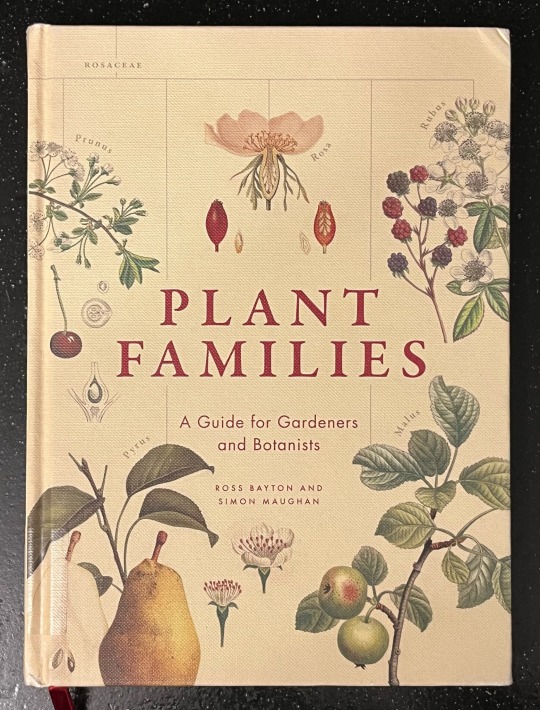

Skipping a picture of the spine tonight because (1) I’m pretty sure I can get away with it, and also (2) image limit constraints.
The How
Bought new somewhere. Dunno. I think this may have come to my attention by way of the venerable Tony Santoro, but I’ve slept since then. I have several books whose titles I read in his voice, at any rate.
The Text
‘For Gardeners and Botanists’ feels…mostly right? Plant enthusiasts might sit better. Some of this is high school biology review, some of it is a little more cerebral, but mostly it’s kept nice and approachable. No subject sticks around very long; between an intro and several dozen families with two (sometimes four) pages given to each, this things moves fast.


This moves more or less in order of evolutionary appearance, which is both handy and a no-brainer. Some attention is given to uses — a thing I chronically feel conflicted about because I’m an asshole — but in general, evolutionary details, range, characteristic traits, and salient genera are foregrounded. It’s what you’d expect from Royal Horticultural Society/BBC show pigs, for better or worse.
I’m delighted to inform you that the text isn’t limited to Bayton and Maughan’s erudite jawing-off. Most of the RHS Lindley Library got slopped into/slathered onto/smeared all around this thing. Downright orgiastic is what it is.
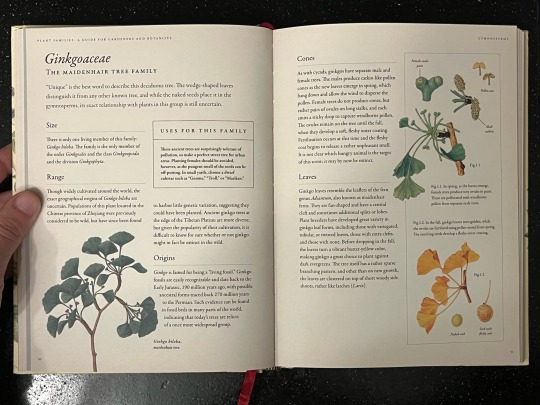


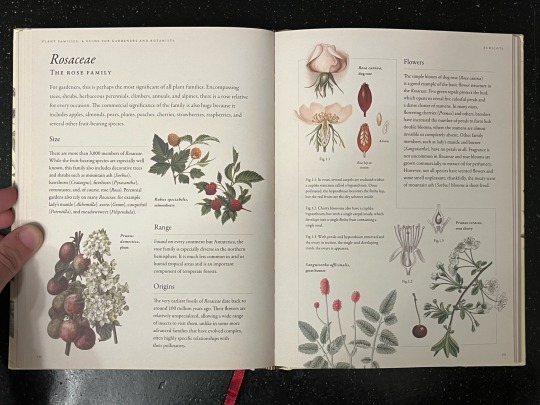
Obviously these are why you’d buy the book (though they’re barely credited; it’s practically impossible to find artist attribution). If you’re interested in getting a useful glossary or index, you could do better. This is for a narrow band of use and a wide band of readership.

The Object
I was thinking earlier today that this is about as nice as a widely available hardcover can get. The binding is solid, the materials are quality, the printing is nice if a little affected (desaturating contemporary plant books as a shorthand for ye lithography is not cute).
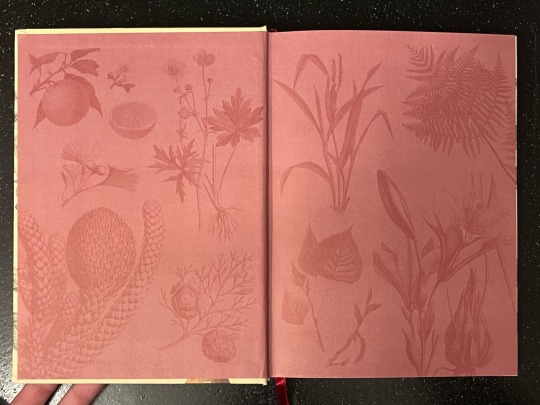
Endpaper registration? Mwah. Crisp. Good form factor and feels nice in the hand. Highly legible design work, against all odds. This is an object made to look appealing that actually (gasp) is.
The Why, Though?
I lend this out relatively often because it’s easy to convince people to accept. It’s a crunchy, satisfying read, and the real lessons it teaches are structural. Most people haven’t interacted with plant phylogeny and identification the way they’re presented here, but even five minutes of looking at the spreads gets the message across.
I do pull this (and a sister book from the same series; stay tuned for next week) myself only occasionally, mostly as a stepping stone for writing about specific families. As a teaching tool I think this is superb, but only as part of a larger set of resources. As a read, eh. It’s really meant to be bought (that is, sold) and handled; the rest feels like the kind of accident that tends to happen when big spenders find the right big names to rope into medium-sized projects.
39 notes
·
View notes
Note
If Oklahoma is neither a midwestern nor southwestern state, what is it classified as? No clue if it’s Oklarkatex or Just Oklahoma. Obviously my line of reasoning ignores things like bio and ecoregions in this case.
It's a Southern state, same as Texas.
Prepare for all the screaming and raging, now, because I said it; they do not like it when I say it. But it's the truth: Our formal classification is Southern- as is our dialect / language, our food and material culture, a not-insignificant part of our ecology, and quite a "fun" chunk of our history (the later being said with all the distaste and sarcasm that the history of the Confederacy deserves, and then some more for good measure).
#Even Southern Living Recognizes Us As Southern But Don't Tell The Traditionalists That#Answered Asks#2024 Asks#2024#resolvedbrunette#Some Of Y'all Have Not Studied The History Of The Cherokee Nation And It Shows#Casual Reminder That Oklahoma Is NOT A Midwestern OR Southwestern State#Oklahoma Ecology#Gardening Asks
3 notes
·
View notes
Photo

The Bolivian Lowlands This photograph, taken by a crew member aboard the International Space Station, shows part of the Bolivian Yungas. The heavily forested ecoregion is in the lowlands of the Andes and neighbors the highlands of the Amazon rainforest. The section of the Beni River pictured here flows northeast as it meanders across the lowlands. The sinuous river channel (brown) is juxtaposed against the vegetated floodplain (green). As it flows through the lush, topographically complex landscape, the water carries a heavy sediment load that accumulates at the river’s curves. The transport and deposition of sediment erodes the riverbank, causing remnants of the main river channel to cut off and form oxbow lakes. The image also includes several examples of “oriented lakes” that are also known as “lagos cuadrados” (square lakes) because of their rectangular shape. Lake Rogagua is one of the largest of dozens of such lakes in central South America. The lakes, only a few meters deep, are notably oriented in the same direction with their long axes positioned northeast to southwest. Some scientists think that the pattern relates to the dominant wind direction in South America’s recent geological past. At the time, the landscape was drier and vegetation cover was thinner or absent, which allowed winds to excavate shallow depressions in the landscape. The depressions later filled with water when the climate became wetter. Astronaut photograph ISS069-E-66 was acquired on March 28, 2023, with a Nikon D4 digital camera using a focal length of 56 millimeters. It is provided by the ISS Crew Earth Observations Facility and the Earth Science and Remote Sensing Unit, Johnson Space Center. The image was taken by members of the Expedition 69 crew. The image has been cropped and enhanced to improve contrast, and lens artifacts have been removed. The International Space Station Program supports the laboratory as part of the ISS National Lab to help astronauts take pictures of Earth that will be of the greatest value to scientists and the public, and to make those images freely available on the Internet. Additional images taken by astronauts and cosmonauts can be viewed at the NASA/JSC Gateway to Astronaut Photography of Earth. Caption by Amber Turner, Jacobs JETS Contract at NASA-JSC and Justin Wilkinson, Texas State University, Jacobs JETS Contract at NASA-JSC .
0 notes
Text
Wild Southwest Project Information
Introduction
This blog serves as a platform for my Citizen Science project, assigned in my Conservation Ecology class for the online MNR program at Virginia Tech. For those unaware, citizen science is the participation of the general public in scientific endeavors. As for the citizen science project itself, the Wild Southwest Project is based on the website Zooniverse and involves scanning images generated by camera traps then identifying the animals within the images. Ran by Rowan Converse, this project is located in an area managed by the US Fish and Wildlife Service and includes the states of Arizona, New Mexico, Oklahoma, and Texas. Some specific places are Sevilleta NWR, Bosque Del Apache NWR, and Red Rock WMA in NM as well as the Wichita Mountains NWR in OK (Converse 2022). The Wild Southwest was created to help train an automatic process that can scan an image and identify the animals, which would greatly reduce the amount of time spent clicking through thousands of images.
But what is the importance of this project as a whole? Why game cameras, and why in this particular area? As mentioned on the Wild Southwest site, the southwest is “home to a great diversity of ecosystems and wildlife, including three of the top five US states for wildlife species diversity” (Converse 2022), with Texas coming in at #2 while Arizona and New Mexico are #3 and #4, respectively. A paper by Bruce A. Stein, a member of the National Wildlife Federation, confirms this ranking, with California taking the top spot and Alabama taking the fifth spot (Stein 2002). According to the National Park Service website, the animals within the Southwest depend on vital riparian corridors for breeding and migrations, especially in the case of birds as there are over 400 species within the region (Science of the Southwest: Animals 2022). This importance makes the threats all the more dire, especially since Texas is one of the top five states for both endemism and extinctions (Stein 2002).
The NPS article lists habitat degradation as one of the major threats to this region, with it being responsible for the decline of many species such as the burrowing owl, Texas horned lizard, swift fox, and black-tailed prairie dog (Science of the Southwest: Animals 2022). Habitat fragmentation can also lead to devastating consequences to gene flow, which is vital for the healthy resiliency of a population (Lovich and Ennen 2011). Climate change also poses a threat to this region, with a report by the Third National Climate Assessment citing increased wildfires, insect outbreaks, declining water supplies, erosion, and droughts as major effects of climate change (Blanco et al. 2014). Wetlands in this region are at major risk, with nearly “19% of endangered, threatened and candidate species” being found in the Apache Highlands Ecoregion (Minckley et al. 2013). With a better idea of how many animals frequent an area, certain areas can be given priority for safeguards against habitat fragmentation and climate change (Converse 2022).
Project Design
As mentioned above, the project uses camera traps to gather information about the types of animals in a particular region, as well as things like population size and the effectiveness of habitat restoration. Cameras are often more effective than human researchers, as the camera traps can be placed in remote areas where humans do not often frequent (Converse 2022). The lack of humans also increases the chance of rare and elusive animals passing through the area, such as the Mexican grey wolf (Converse 2022). This data is then used to build an algorithm that will automatically identify the animal in an image without researchers needing to check through the images (Converse 2022). Given the rate at which new images are generated by the motioned sensor, this will greatly streamline the process of identifying animals within a region. This also can streamline inputting the data from the camera into the computer (Converse 2022).
I found the project and its premise very fascinating, and a data trained algorithm identifying camera data on its own will be vital for the future of conservation. As some of the most threatened areas are also the most remote, using cameras will reduce the risk to both humans and the highly sensitive habitat being researched. For example, the Artic and Antacrtic are both rather hostile to humans as a whole, so having remote cameras there could greatly improve the research conducted in these areas. The head researcher also has the data available upon request, which can be implemented in other areas. This research collaboration is very important going forward, and will help other areas advance in their own fields as they would not have to focus on something already done by another researcher. No need to reinvent the wheel, after all.
Outreach and Participation
The overall mechanics of the project on Zooniverse are very clean and simple. I did not have to undergo intense training before working on the camera identification, and the tutorial was always available if I forgot how the program worked. The tutorial, shown in the Tutorial section below, demonstrated how to mark which animals were in the image. It also gave great instructions on how to draw the box around the animals. As for outreach, the program has a link to request the data for other researchers looking to build a similar program, or scientists looking to study populations within these areas. It also is creating a website for teachers to bring the project into the classroom through team tracking and custom team challenges. I’ve greatly enjoyed the project so far, as it gives me something productive to do from day to day. Even when this term ends, I can see myself continuing with this project and I will also recommend this project to other people who are looking to get involved with citizen science projects. For the project itself, the only recommendation I would have is adding a few more bird species to the selection instead of “Turkey or Not Turkey”.
Tutorial
Below I have attached screenshots of the tutorial I underwent. If at any time I needed extra help with animals, there was also a chat area where other members would be able to aid me. The field guide was also always available.
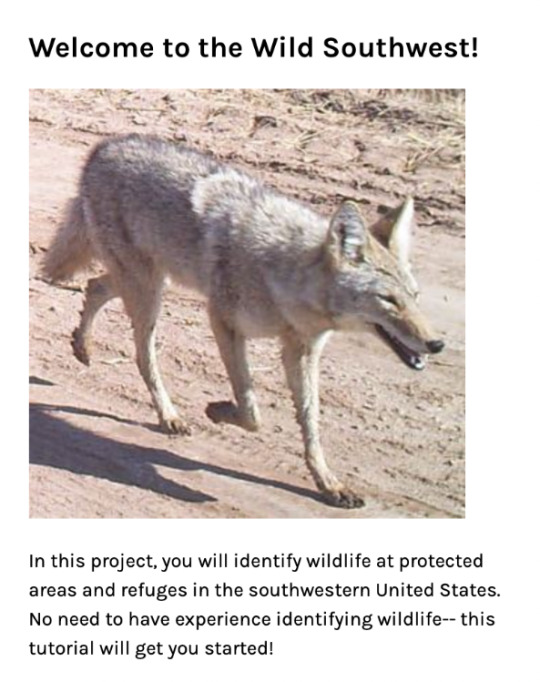


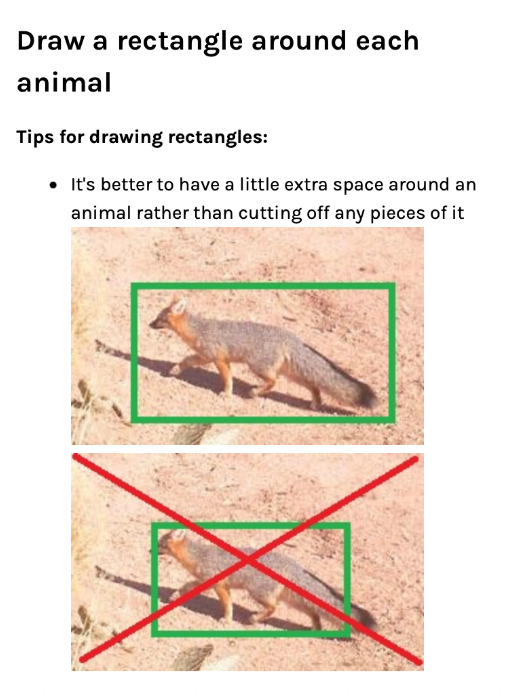
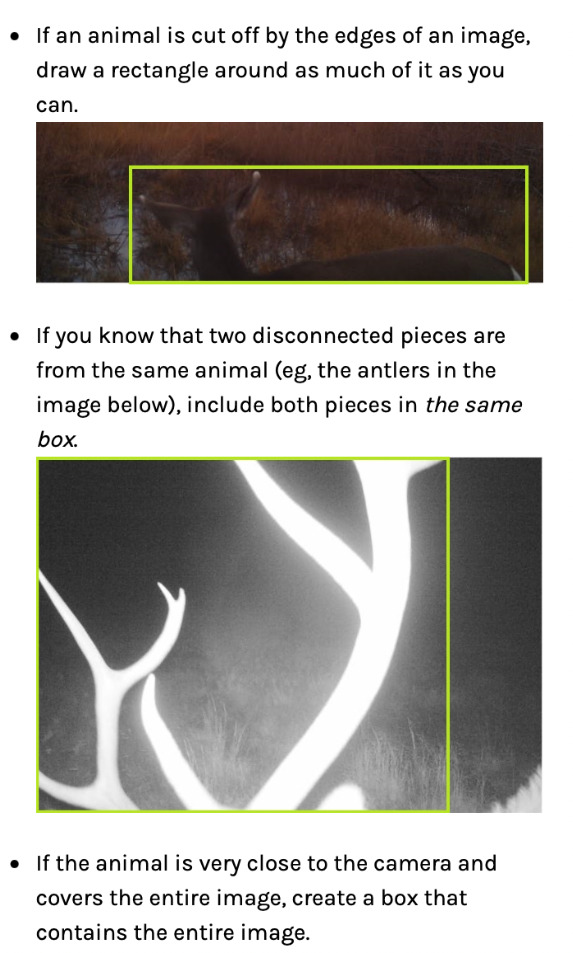


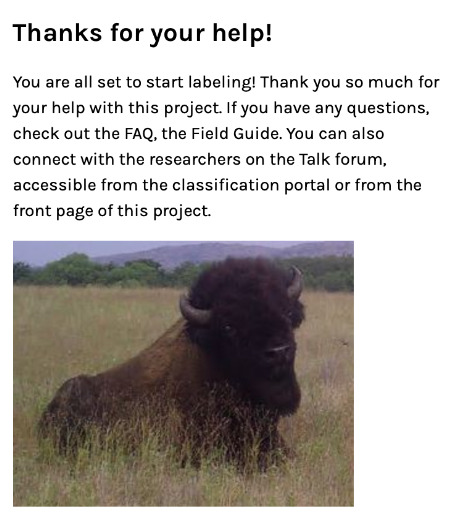
Sources
2022. “Science of the American Southwest: Animals”. NPS.gov. https://www.nps.gov/subjects/swscience/animals.htm
Blanco, H. Comrie, A. Gonzalez, P. Piechota, T. Smyth, R. Waskom, R. 2014. “Southwest”. Globalchange.gov. https://nca2014.globalchange.gov/report/regions/southwest#:~:text=Increased%20heat%2C%20drought%2C%20and%20insect,change%20is%20affecting%20the%20Southwest.
Converse, R. 2022. “Wildlife in the Southwest”. Zooniverse.org. https://www.zooniverse.org/projects/rowan-aspire/the-wild-southwest/about/research
Lovich, J. Ennen, J. 2011. “Wildlife Conservation and Solar Energy Development in the Desert Southwest, United States”. Bioscience 61(2): 982-992. https://academic.oup.com/bioscience/article/61/12/982/392612.
Minckley, T.A. Turner, D.S. Weinstein, S.R. 2013. “The relevance of wetland conservation in arid regions: A re-examination of vanishing communities in the American Southwest”. Journal of Arid Environments 88: 213-221. https://www.sciencedirect.com/science/article/abs/pii/S0140196312002431.
Stein, B. A. 2002. “States of the Union: Ranking America's Biodiversity”. Researchgate.net. https://www.researchgate.net/publication/269111849_States_of_the_Union_Ranking_America's_Biodiversity#:~:text=biodiversity%20as%20measured%20by%20these,Hawaii%2C%20Texas%2C%20and%20Alabama.&text=California%20is%20a%20remarkable%20state,in%20each%20of%20these%20categories.
0 notes
Photo

Ghost of the Blackland Prairie
The blackland prairie ecoregion of Texas was once home to jaguars. The last known jaguar in Texas was killed in the 1940s.
I like to hope that one day the jaguars can return.
2K notes
·
View notes
Text
thinking about her (shinnery oak). also thinking about her (High Plains sand dunes region). and her (dunes sagebrush lizard). and her, too (lesser prairie chicken). i’d think that shinnery oak dunes must be one of the more unique habitats/ecosystems in all of temperate North America, as picturesque and complex and rare as they are, which somehow still receives little attention outside of the region. and i think there’s at least one notable reason for the silence. including how the extremely rare endemic sand dune-dwelling lizard “threatens national security.”




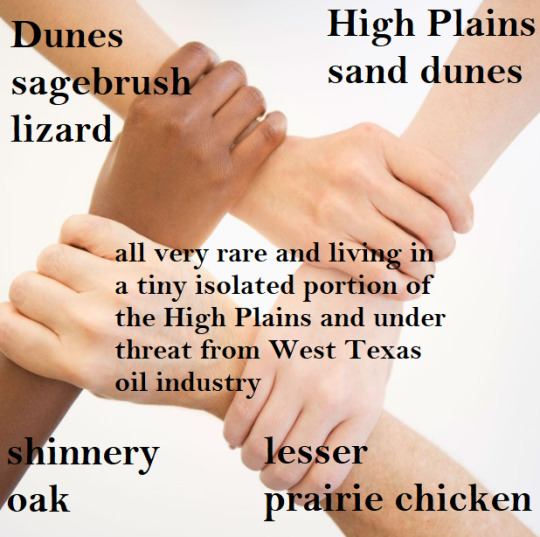
you’ve got these extensive sand dunes that only exist in a really isolated, “small” range, in a kinda strange or unexpected region: the shortgrass prairies of the so-called “High Plains ecoregion” (of the Texas panhandle and nearby portions of New Mexico, southeastern Colorado, and the Oklahoma panhandle).
and then there is this species of oak, the shinnery oak (Quercus havardii) that is entirely endemic to these sand dune landscapes.
and even though this bird used to live in a bit of a broader range across the High Plains, the lesser prairie chicken (Tympanuchus pallidicinctus) is now pretty much living only near shinnery oak/dune habitats.
and finally, you have a very special reptile: the dunes sagebrush lizard, or just “dune lizard” (Sceloporus arenicolus), which is entirely endemic to, limited to, sand dunes with shinnery oak habitat.
and the distribution of shinnery oak, the sand dunes, the prairie chicken, and the lizard all match each other. and these sand dunes aren’t in, like, “traditional” desert, they are firmly located within a prairie/grassland/plains region.
i have some thoughts on why the shinnery oak dunes don’t seem to get a lot of publicity outside of the region:

that map displays the entire global distribution range of the dunes sagebrush lizard, compared to West Texas fossil fuel industry oil and gas wells (in orange and red)
West Texas, baby.




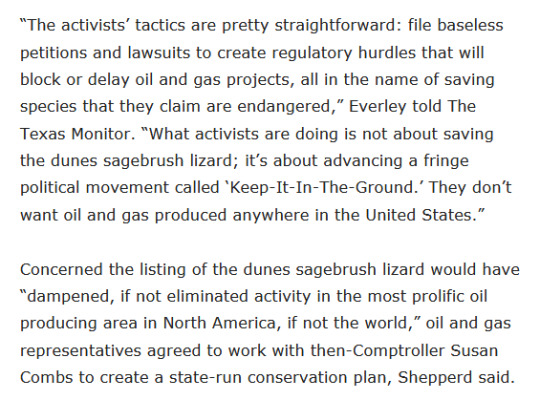

this lizard is threatening national security:

---
anyway, check out how closely the distribution of oak, sand dunes, prairie chicken, and the lizard all match each other.
the distribution range of shinnery oak:
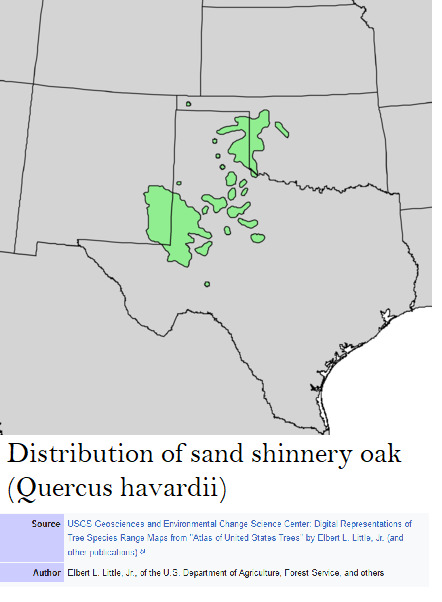
compare the shinnery oak distribution to the distribution of the lesser prairie chicken:


the distribution of sand dunes in the High Plains region:

and the distribution of the lizards:

and the distribution of shinnery oak dune landscapes generally:
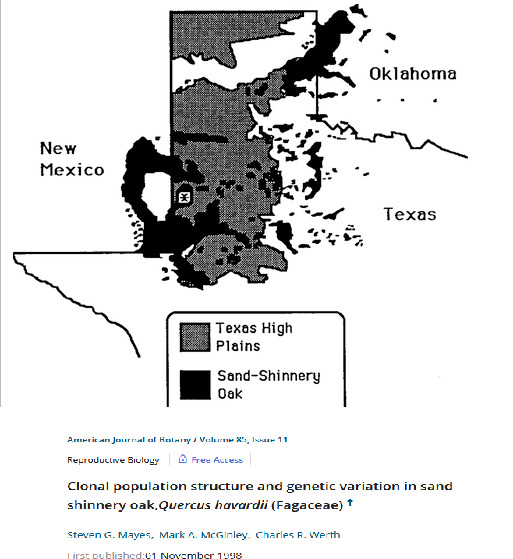
here’s a look at dunes sagebrush lizard habitat:

more lizard stuff:

check out how cool the shinnery oak and dunes look from above, neat patterns:



leave her alone
127 notes
·
View notes
Quote
The rolling to nearly level plains of the Northern Blackland Prairie ecoregion are underlain by interbedded chalks, marls, limestones, and shales of Cretaceous age. Soils are mostly fine-textured, dark, calcareous, and productive Vertisols. Historical vegetation was dominated by little bluestem, big bluestem, yellow Indiangrass, and tall dropseed. In lowlands and more mesic sites, such as on some of the clayey Vertisol soils in the higher precipitation areas to the northeast, dominant grasses were eastern gamagrass and switchgrass. Also in the northeast, over loamy Alfisols, were grass communities dominated by Silveanus dropseed, Mead’s sedge, bluestems, and long-spike tridens. Common forbs included asters, prairie bluet, prairie clovers, and black-eyed susan. Stream bottoms were often wooded with bur oak, Shumard oak, sugar hackberry, elm, ash, eastern cottonwood, and pecan. Most of the prairie has been converted to cropland, non-native pasture, and expanding urban uses around Dallas, Waco, Austin, and San Antonio.
Descriptions of the Level IV Ecoregions of Texas
3 notes
·
View notes
Text

Acacia National Park! Maine’s Acadia National Park straddles eastern-deciduous and northern-boreal forests, attracting breeding songbirds, including nearly two-dozen warbler species, in summer. By 2050, as temperatures increase, boreal songbirds like Bay-breasted Warblers and Boreal Chickadees may be extirpated and move to cooler forests north of the park. At the same time, Acadia’s waters are poised to grow more crowded; waterbirds like the American Bittern and Pied-billed Grebe might skip their southbound migrations and winter in Maine instead. And Maine’s beloved Common Loon might stop breeding in the park. It is recommended that managers maintain wetlands and continue to track breeding warblers.
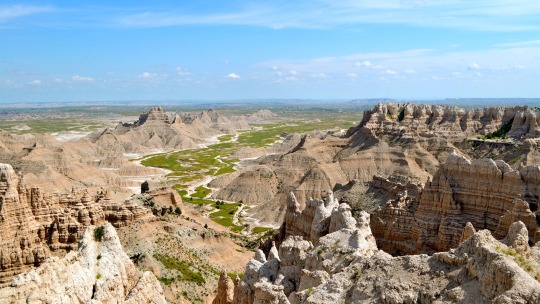
Badlands National Park! Best known for its rugged formations, South Dakota's Badlands National Park is also a birding destination for its grassland species. By 2050, hotter conditions may trigger declines in grassland birds that breed there in summer, such as Upland Sandpiper, Horned Lark, and Burrowing Owl, and the Mountain Bluebird may be extirpated from the park. Meanwhile, species more adapted to the arid Great Plains, including the Mississippi Kite, Northern Bobwhite, and Scissor-tailed Flycatcher, and the Southwest, like Scaled Quail, Cassin’s Kingbird, and Chihuahuan Raven, will likely thrive within its borders. Preserving healthy grasslands will give all birds the best chance possible.

Big Bend National Park! In western Texas along the Mexican border, Big Bend National Park is the largest protected area of Chihuahuan Desert in the U.S. The park consists of vibrant desert habitat, including mountain woodlands and rivers, and supports hundreds of bird species. After the annual spring bloom, birds become scarce during June and July’s hot, dry period; a second flowering and nesting cycle follows, in August and September, during the summer rainy season.
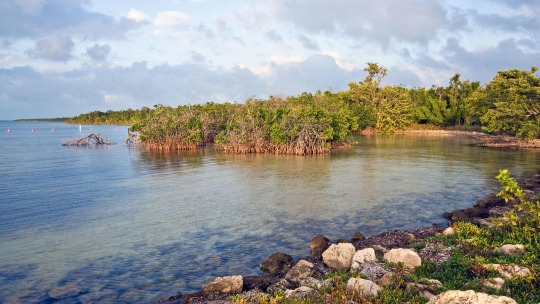
Biscayne National Park! Located in southern Florida, Biscayne National Park is 95 percent water and is home to numerous bird species, including loons, warblers, grebes, wading birds, and pelicans. Part of the Greater Everglades Ecosystem, the park suffers from inadequate freshwater flows, increased salinities, and an ever-growing Miami encroaching on its banks. Along with advancing Everglades restoration components specific to Biscayne Bay, managers can help bird species adapt to a changing climate by working with cooperating agencies and landowners to improve habitat connectivity and buffer zones across boundaries

Black Canyon of the Gunnison National Park! Black Canyon of the Gunnison National Park, located in western Colorado, is marked by wetlands, large rock formations, and deep canyons, such as the Black Canyon, which formed 1.5 billion years ago. Birds live in various habitats lining the canyon—from pygmy forests and oak flats at the rim, to shrubs and wildflowers along the canyon walls, to lush cottonwoods growing around the river at the bottom.

Bryce Canyon National Park! Located in southwestern Utah, Bryce Canyon National Park’s vast, arid landscape supports a diverse range of trees, shrubs, and plants, which support birds and other wildlife. By 2050, the park’s climate may become unsuitable for 19 species in summer, including songbirds like the Ruby-crowned Kinglet, Yellow Warbler, and Song Sparrow. In winter, it may be colonized by 43 species not found there today, including those from drier regions like the Crissal Thrasher and Cactus Wren. Due to its arid climate, water conservation and preservation of riparian habitats will be central for management of park resources.
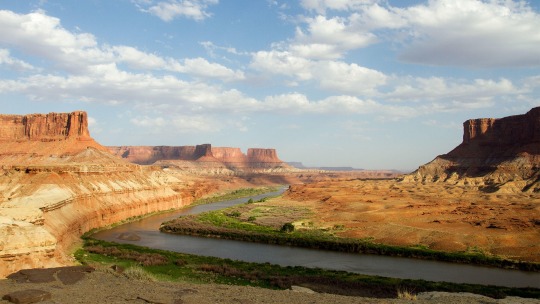
Canyonlands National Park! A recognized Important Bird Area, Canyonlands National Park encompasses the intersection of the Colorado River and the Green River in Utah. In summer, the park’s climate could grow suitable for 19 new bird species like Yellow-crowned Night Herons, Greater Roadrunners, and Painted Buntings by 2050. Unfortunately, park visitors seeking to catch a glimpse of the Gray-crowned Rosy Finch may miss their chance as the climate warms. It is recommended that managers support habitat along the rivers, as this is a refuge for many birds as they migrate across the surrounding desert.

Capitol Reef National Park! At Capitol Reef National Park in south-central Utah, willow thickets and cottonwood forests are juxtaposed against tall canyon walls and expanses of barren red rock. By 2050, this park’s winter climate might become suitable for 57 bird species like the Vermilion Flycatcher, Western Bluebird, and Violet-green Swallow, some of which could begin overwintering in the park. The same climatic changes might cause the extirpation of 20 species in summer, including the American Goldfinch and Tree Swallow. Within Capitol Reef, the Fremont River is an Important Bird Area and a lush oasis in an otherwise arid landscape. It is recommended that managers focus on this area for conservation efforts.
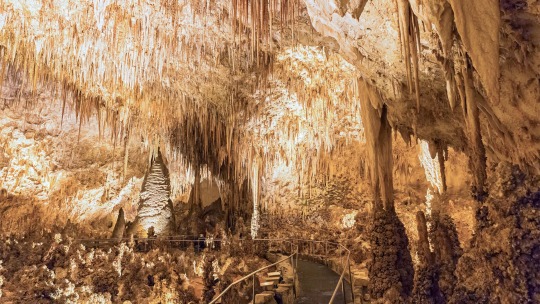
Carlsbad Caverns National Park! New Mexico's Carlsbad Caverns National Park is situated in the Northern Chihuahuan Desert, one of the three most biologically rich and diverse desert ecoregions in the world. Habitats within the park range from lower-elevation desert shrublands and semi-grasslands to higher elevation montane grasslands, shrublands, and woodlands. Riparian woodlands and wetlands are few, but provide critical breeding and stopover habitat for water-loving birds—including Rattlesnake Springs, a designated Important Bird Area. The park is home to 15 species that are highly sensitive to warming temperatures, like the Burrowing Owl. The park will serve as an important refuge for these climate-sensitive species.

Channel Island National Park! Channel Islands National Park includes five remarkable islands off the coast of southern California, where thousands of years of isolation have created unique habitats and bird populations. This Important Bird Area is home to the only breeding ground for Brown Pelican in California, and they're likely to continue finding suitable climate in the park through 2050. Overall, the park’s climate is projected to become suitable for 26 new species in summer and 27 species in winter, which could potentially colonize the islands. It is recommended that managers continue to optimize habitat for its birds, focusing on maintaining appropriate habitat and working with other agencies to ensure that marine food resources are plentiful.
5 notes
·
View notes
Text

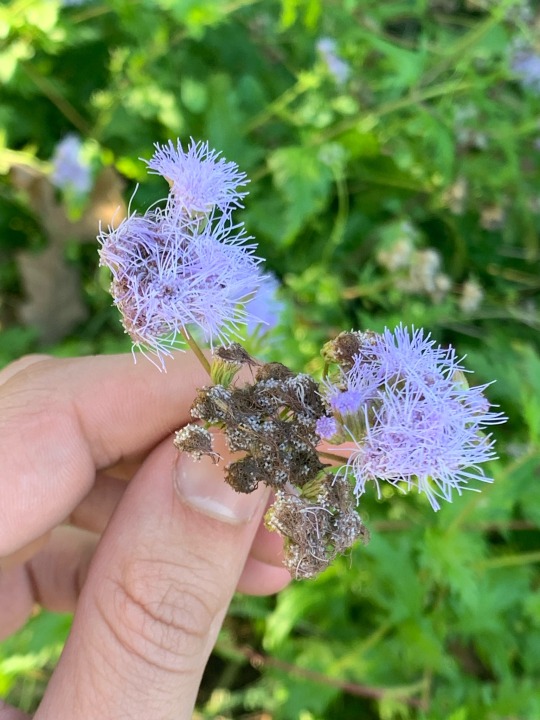
Conoclinium dissectum, Asteraceae.
Nurseries usually sell this as Gregg’s blue mist or Gregg’s mistflower, so that’s how everybody calls it. Good luck getting anyone to recognize the name ‘palm-leaf mistflower’. The eponymous Josiah Gregg is notable for three and a half things:
(1) Writing Commerce of the Prairies: or, The journal of a Santa Fé trader, 1831–1839, which is supposedly an important source on the Santa Fé Trail
(2) Traveling and writing in greater detail about the broader southwest (mostly what’s now Texas), especially its botany
(3) Being the ‘gregg’ in greggii, which shockingly common specific epithet is slowly being replaced by descriptive ones
(.5) Lethally falling off his horse
Most of this plant’s native range is in Mexico; in the US it’s restricted to proximal Texas, New Mexico, and Arizona. The sister species blue mistflower C. coelestinum — less drought tolerant, better with frost, and with undivided leaves — has a much broader range in central and eastern North America, including my ecoregion. Both are important nectar plants for monarch and queen butterflies (respectively Danaus plexippus and Danaus glippus), but in my area C. dissectum is the rule in gardens. Less aggressive and better for visual texture.
The local wetlands have scads of blue mistflower, and I’m told the butterflies have been relatively dense there this year. This little patch made a good account of itself despite being in a weird little ornamental planting. Easily a dozen really active monarchs, which I haven’t seen the like of recently. The migratory traffic used to be much thicker, but these days single sightings and the odd handful are trophies close to town.
31 notes
·
View notes
Text

Day 6 of Jasmyne Ambrosia's 28 Day Witchy Challenge: Research Your Bioregion and see what's growing in your area.
Yesterday I was so busy I didn't have time to post my entry; I had all my prep for the Tu BiShvat ritual- plus I had to evaluate a new bed we're taking over at the Botanical Garden and help to come up with a remediation and planting plan for the upcoming season. Then I got a wild hair to stop by the library on the way home (even though I was already pressed for time for the ritual).
Glad I did, though, because I found a few new gems and (refound) a couple old friends I've read before but didn't complete - and / or am up for re-studying since I'm growing some listed in them this year ➺
📚 'The Telling: How Judaism's Essential Book Reveals the Meaning of Life' by Mark Gerson
📚 'The Twelve Wild Swans' by Starhawk & Hilary Valentine
📚 'Our Native Bees: North America's Endangered Pollinators and the Fight to Save Them' by Paige Embry
📖 'The Witching Herbs: 13 Essential Plants and Herbs for Your Magical Garden' by Harold Roth
📚 'Wild Witchcraft: Folk Herbalism, Garden Magic, and Foraging for Spells, Rituals and Remedies' by Rebecca Beyer
📖 'Spiritual Herbalism: The Magic and Medicine of Plants' by He Who I Refuse To Name Anymore
📖 'Urban Foraging: Find, Gather, and Cook 50 Wild Plants' by Lisa Rose
📚 'Tomorrow there Will Be Apricots' by Jessica Soffer (amazing! I actually checked out a fictional book for once! And it has a Jewish character!)
Regarding the prompt: Oklahoma has the most diverse ecosystem per square mile compared to any other state in the United States- boasting a whopping 22 unique ecoregions within its borders; as a Southern Transition Zone state, we beat out Alaska, California, and Texas all for sheer compact diversity ... I haven't visited most of them, however; as a prior Civilian Conservationist my focus was the 9.4.2 Subregion (South Central Semi-Arid Prairies) of the 9th North American Bioregion (Great Plains).
Today I no longer live in the country, in the wilds where I grew up, though. And so I'm beginning to focus on learning Urban Foraging and Landscaping; what is forgotten in environmentalism, activism, and the like, is that we too need to change and adapt with our environments.
As an Ecoregional Vitalist, prior Civilian Conservationist, current Master Gardener, training Rosarian, Lay Herbalist, Verderer, and all around plant person specializing in native plants and edibles, though ... Today, for once, I'll spare y'all my usual rant about how most people actually mean "Ecoregion" or "Microregion" whenever they say "Bioregion"- and how "Bioregional Animism" and similar practices aren't TRULY a thing for most people who claim them as a result.
#Casual Reminder That Oklahoma Is NOT A Midwestern OR Southwestern State#Personal#2023#28DayWitchy#28DayWitchyChallenge#WitchChallenge#Instagram Reposts#Religion & Magic#A Direct Look At My Practice#Natural Connections#Calendar Nonsense#Master Gardening#Master Gardeners#Bookshelf#Great Plains Foraging
5 notes
·
View notes
Text

Monsta Trucks. Autoexotics, 2009.
📸 Canon PowerShot S3 IS, 6mm, iso 75, 1/1250 sec, f4
⠀
The star known as LP 327-186, the so-called white dwarf, is smaller than the state of Texas. But it is so dense that if a cubic inch of it were moved to earth, it would weigh more than 1.5 million tons.
⠀
#Cloud #Tire #Wheel #Sky #Car #Vehicle #Ecoregion #Automotivetire #Motorvehicle #Offroadracing #Cloud #Tire #Wheel #Sky #Car #Vehicle #Ecoregion #Car #Vehicle #Off-Road Racing
0 notes
